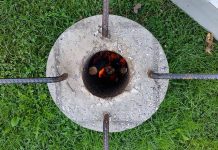Here is a very detailed explanation of how to build a diy rocket stove core. Rocket stoves are a great way to use a minimal amount of wood for a large amount of energy output. I have seen videos of different builds on the net using different materials; such as stove pipe, bricks and mud.
This video does a great job of actually breaking down the process of building the most important piece, the core.
[quote_box_center]A rocket stove achieves efficient combustion of the fuel at a high temperature by ensuring a good air draft into the fire, controlled use of fuel, complete combustion of volatiles, and efficient use of the resultant heat. It has been used for cooking purposes in many energy poor locales (notably Rwandan refugee camps) as well as for space and water heating.
A rocket stove’s main components are:
- Fuel magazine: Into which the unburned fuel is placed and from which it feeds into the combustion chamber
- Combustion chamber: At the end of the fuel magazine, where the fuel burns
- Chimney: A vertical chimney above the combustion chamber to provide the updraft needed to maintain combustion
- Heat exchanger: To transfer the heat to where it is needed (cooking pot or other load).
The fuel magazine can be horizontal, with additional fuel added manually, or vertical, with fuel automatically fed. As the fuel burns in the combustion chamber, convection draws new air into the combustion chamber from below, ensuring that any smoke from smoldering wood near the fire is also drawn into the fire and up the chimney. The chimney can be insulated to increase the temperature and improve combustion; according to studies this can increase efficiency by up to two percent. In a rocket mass heater, the heat is passed to a heat exchanger to ensure the efficient use of the generated heat.
For cooking purposes, the design keeps the cooking vessel in contact with the fire over the largest possible surface area. A pot skirt can be used to create a narrow channel that forces hot air and gas to flow along the bottom and sides of the cooking vessel. Optional baffles guide hot air and flame up the sides of the pot. For space heating purposes, the heat is transferred to a heat store which can, in some cases, be part of the structure of the house itself. The exhaust gases then pass out of the building via the chimney.
The design of the rocket stove allows it to operate on about half as much fuel as a traditional open fire, and it can use smaller-diameter wood. If the stove is insulated and raised from the floor, the danger of children burning themselves is reduced. Some more recently designed rocket stoves are self-feeding, using gravity to add fuel to the fire as required. Source[/quote_box_center]
So if you are concerned about rising energy prices, take a look at a rocket stove, it might just fulfill some of your energy needs.
 Rocket Mass Heaters: Super efficient Wood-stoves YOU Can Build
Rocket Mass Heaters: Super efficient Wood-stoves YOU Can Build
Here is a superefficient wood fired heater you can build for yourself in a weekend for less than a hundred dollars. This book explains in detail exactly how to build one, then how to use it in a range of applications. We discuss materials: where to find them, what to pay and how to make use of found and recycled parts. The section on fire and fuels is thorough but simple; we tried to keep away from numbers wherever possible.




